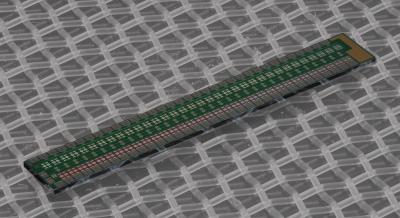NIST chips help BICEP2 telescope find direct evidence of origin of the universe

NIST chip identical to the 16 chips integrated into the BICEP2 telescope camera at the South Pole. Each custom superconducting circuit chip amplifies the electrical signals generated by 32 microwave detectors and assembles them into a sequential time stream. Credit: Schmidt/NIST
A team of U.S. cosmologists using the BICEP2 telescope at the South Pole announced this week that they have discovered the first direct evidence of the rapid inflation of the universe at the dawn of time, thanks in part to technology developed and built by the National Institute of Standards and Technology (NIST).
The BICEP2 camera relies, in part, on the extraordinary signal amplification made possible by NIST's superconducting quantum interference devices (SQUIDs).
The team of cosmologists from Harvard University, the University of Minnesota, the California Institute of Technology/Jet Propulsion Laboratory (JPL) and Stanford University/SLAC used BICEP2 to observe telltale patterns in the cosmic microwave background—the afterglow of the Big Bang almost 14 billion years ago—that support the leading theory about the origins of the universe.
The patterns, so-called “B-mode polarization,” are the signature of gravitational waves, or ripples in space-time. These waves are direct evidence that the currently observable universe expanded rapidly from a subatomic volume in the first tiny fraction of a second after the Big Bang. The project was funded by the National Science Foundation.
Researchers at NIST's campus in Boulder, Colo., made the custom superconducting circuits, or chips, that amplify electrical signals generated by microwave detectors measuring primordial particles of light. JPL made the detectors. The NIST chips, which along with the detectors are chilled to cryogenic temperatures, also assemble the signals into a sequential time stream that can be read by conventional room-temperature electronics.
“This is an exciting and important new result, and we are pleased that technology developed at NIST played a role,” said physicist Gene Hilton, who was responsible for production of the NIST chips.
The 16 NIST chips contain a total of more than 2,000 SQUIDs, which measure the magnetic fields created in coils that carry and amplify the very small currents generated by the detectors. NIST researchers invented a method for wiring hundreds of SQUID signal amplifiers together to make large arrays of superconducting detectors practical—part of the cutting-edge technology that helps make BICEP2 especially powerful.
Physicists just celebrated the 50th anniversary of the SQUID, which has broad applications from medicine to mining and materials analysis—and now more than ever, cosmology.
For more on the BICEP2 discovery, see the Harvard announcement, “First Direct Evidence of Cosmic Inflation,” at http://www.cfa.harvard.edu/news/2014-05.
Media Contact
All latest news from the category: Physics and Astronomy
This area deals with the fundamental laws and building blocks of nature and how they interact, the properties and the behavior of matter, and research into space and time and their structures.
innovations-report provides in-depth reports and articles on subjects such as astrophysics, laser technologies, nuclear, quantum, particle and solid-state physics, nanotechnologies, planetary research and findings (Mars, Venus) and developments related to the Hubble Telescope.
Newest articles

Webb captures top of iconic horsehead nebula in unprecedented detail
NASA’s James Webb Space Telescope has captured the sharpest infrared images to date of a zoomed-in portion of one of the most distinctive objects in our skies, the Horsehead Nebula….

Cost-effective, high-capacity, and cyclable lithium-ion battery cathodes
Charge-recharge cycling of lithium-superrich iron oxide, a cost-effective and high-capacity cathode for new-generation lithium-ion batteries, can be greatly improved by doping with readily available mineral elements. The energy capacity and…

Novel genetic plant regeneration approach
…without the application of phytohormones. Researchers develop a novel plant regeneration approach by modulating the expression of genes that control plant cell differentiation. For ages now, plants have been the…





















